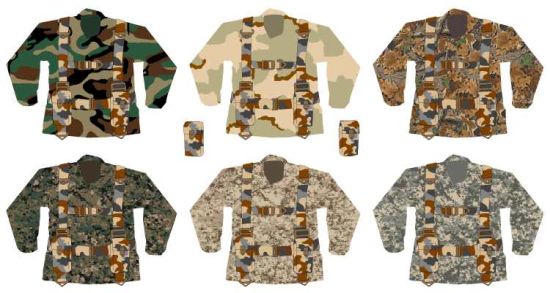

 Many thanks to Jade Geko for the illustration of how DWP might possibly look worn with various patterns of camouflage (above). The upper row shows Woodland, Three-Colour Desert and Advantage; the lower shows Woodland MARPAT, Desert MARPAT and ARPAT. Webbing illustrated is a modified STABO pattern as suggested on this webpage.
Many thanks to Jade Geko for the illustration of how DWP might possibly look worn with various patterns of camouflage (above). The upper row shows Woodland, Three-Colour Desert and Advantage; the lower shows Woodland MARPAT, Desert MARPAT and ARPAT. Webbing illustrated is a modified STABO pattern as suggested on this webpage.
| "Brown-Yellow" Khaki | #CCC66C | ||||||||||||||
| Green-brown "Khaki drab" | #9F9F6F | ||||||||||||||
| Olive-drab | #909000 | ||||||||||||||
| Neutral grey/ Silver | #C0C0C0 | ||||||||||||||
| Beige | #F0E0BF | ||||||||||||||
| Red-brown/ Dark chestnut | #986960 | ||||||||||||||
| Charcoal/ Dark slate gray | #2F4F4F | ||||||||||||||
| Green/ Fern green | #4F7942 |
By the Author of the Scrapboard : | |
|---|---|
 | Attack, Avoid, Survive: Essential Principles of Self Defence Available in Handy A5 and US Trade Formats. |
 | |
 | Crash Combat Fourth Edition Epub edition Fourth Edition. |
 | |
 | |